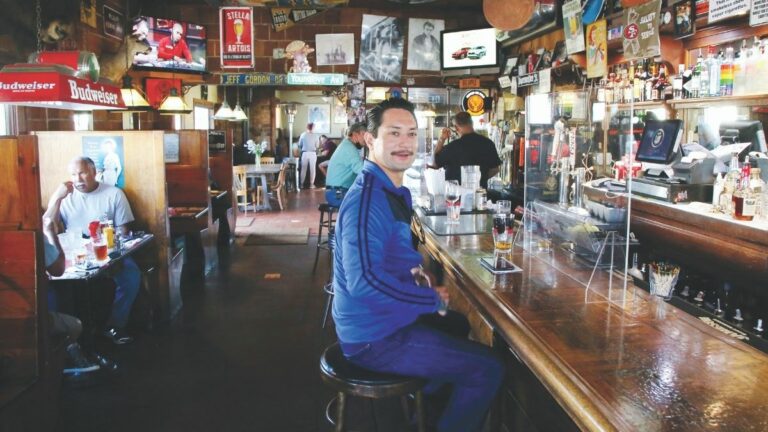When Ashley Perlitch learned the Scotts Valley Unified School District would raise the rainbow flag in May to honor Harvey Milk—the first openly gay elected official in California, who was assassinated in 1978—she was thrilled. The founder of the private Scotts Valley Families for Social Justice Facebook group, a forum for parents to work through problems their children face with racial bias and other inclusivity issues, thought it would be a great learning experience for her first-grade daughter.
“We were super excited,” she says. “This is the first year the school is doing it.”
And it gave her an idea: Why not keep the flag up for Pride Month in June? So she started a Google Doc and asked for parents with kids in the district to put their names down to strengthen the initiative. “My intention was to show the district we had community support,” she says, adding they got around 50 people on the quasi-petition.
As the signatures were rolling in, Perlitch received a message back from the district superintendent, who informed her the May flag-raising had generated blowback, and another one was out of the question—for now.
“The situation has caused all districts to take a pause on raising different flags,” Superintendent Tanya Krause wrote to Perlitch. “This action created some consternation and also multiple requests for a variety of flags to be raised.”
However, next year, she assured Perlitch, the district would revisit this “sensitive and important” issue.
“The County Superintendent is working with legal counsel and CSBA [the California School Boards Association] to review policies around this type of action,” she wrote. “In the meantime, we are going to discontinue raising any flags except for the U.S. and State flags.”
It wasn’t the response Perlitch was hoping for—by a long shot.
“I personally feel like we’re just dragging our feet,” she says, noting she believes administrators bowed to pressure from people who believe the rainbow flag is a political gesture, or that gay rights is a topic best left for home discussions. “I don’t think that Scotts Valley is full of bigots or anything. I just think there are people who are scared of change.”
Raising a Question
Flag-raising rule-changes are being evaluated in civic circles across the region—in some cases for the first time ever, highlighting the tightrope local elected officials are trying to walk as they attempt to streamline a patchwork of ceremonial approaches into a cohesive set of guidelines.
Watsonville raised a rainbow flag on May 28 and will leave it up for the month of June—the decision also forced the city to establish a flag-raising policy. The city of Santa Cruz raised a rainbow flag on June 1, and this isn’t the first year they’ve flown the Pride banner. Capitola approved a flag policy on May 27 and raised its rainbow flag on June 1. It will fly there for the rest of the month, says Larry Laurent, the assistant to Capitola’s city manager Jamie Goldstein.
At the June 16 Scotts Valley City Council meeting, Mayor Derek Timm, the leader of the only city in the county that hasn’t raised a rainbow flag for Pride Month, plans to honor the Santa Cruz County Diversity Center with a resolution and make a motion to direct staff to draft a flag-raising policy. A staffing shortage prevented them from acting sooner, he says.
County officials have not yet been asked to fly the Pride flag but would’ve been happy to, according to county spokesperson Jason Hoppin. While they aren’t officially flying the rainbow colors this month, some of their facilities have done so in the past, he noted.
This year was deemed a breakthrough for the LGBTQ+ community in the local political realm, as the mayors of the county’s two largest cities (Jimmy Dutra of Watsonville and Donna Meyers of Santa Cruz) are both openly gay. They are only the second and third openly gay mayors in the county’s history—current California State Sen. John Laird being the first.
More than 120 people showed up to Watsonville’s first-ever Pride flag-raising, and Dutra, who led the festivities, called the ceremony a sign that “we have come a long way.”
Excellent Outcomes
When contacted June 3 by GT, a CSBA spokesperson said their organization, which represents public schools in California, had not been in contact with Scotts Valley Unified directly, or with Santa Cruz County’s Office of Education, about flag-raisings.
But they do have a “ceremony and observances” policy that allows local school boards to come up with their own rules, according to Chief Information Officer Troy Flint, who added the text of their equity policy includes “sexual orientation” and “gender identity” in the wording.
“If you don’t have a positive social climate at your schools, you’re not going to achieve excellent outcomes,” Flint says. “We will continue to be firm in our belief that we need to respect students of various backgrounds; that is not just our perspective—it’s really the perspective of California law.”
California’s education code says no one “shall be subjected to discrimination on the basis of disability, gender, gender identity, gender expression, nationality, political affiliation, race or ethnicity, religion, sexual orientation, or any other characteristic that is contained in the definition of hate crimes,” among other rules about inclusivity in learning.
“We expect local districts to stand up for students of different gender identities and different sexual orientations,” Flint says. “When you make policy, you make it broad enough that it’s clear what the goal is. Then at the local level you have to trust that the governance teams will be able to apply that in a way that fulfills the intent of the policy.”
Scotts Valley Unified’s flag-raising was part of a countywide initiative on May 17-21, County Superintendent of Schools Faris Sabbah said in an email interview.
“I absolutely believe that flying the rainbow flag is aligned with the County Office of Education’s effort for diversity, equity, and inclusion,” he says, noting his staff partnered with the Safe Schools Initiative to distribute materials about Harvey Milk and shared optional curriculum with teachers. “We were so proud to see the flag raised at so many schools across the county.”
Now, he says, his office is drafting an official flag-raising policy.
“We are sending out this draft policy to all districts for their boards to consider implementing,” he says, adding his office is flying the Pride Flag for the entire month of June.
Mike Heffner, superintendent-principal of the Bonny Doon Union Elementary School District, says the district raised the rainbow flag “as a symbol of acceptance and inclusivity.”
Not having a flag-raising policy in place didn’t complicate the process this time, he says, but adds, “We are working to update our policy and administrative regulations for greater clarity in the future.”
Michelle Rodriguez, superintendent of the Pajaro Valley Unified School District, says the district has an LGBTQ+ task force that helped create the Feb. 24 board resolution that allowed it to raise the progress flag. This was a similar process to when the district chose to fly a flag honoring soldiers missing in action, or who have become prisoners of war, she says.
The rainbow colors will also fly for the month of October to recognize National Coming Out Day, on the 11th of the month, she says, adding the objective is “to inspire equity, create alliances, celebrate diversity, and establish a safe environment in our schools and community.”
Teaching Moments
Perlitch says she was inspired to create her social justice group in the wake of Black Lives Matter protests in Scotts Valley. At the time, she says, she felt like Scotts Valley Unified wasn’t doing enough to deal with diversity problems—particularly racial bias.
“It didn’t seem like the school was really addressing it in an appropriate way,” she says. “I started this group to build a community around it.”
As a woman of Mexican descent married to a Jewish husband, with one child in the district and another who soon will be, the subject is close to her heart. Far from a social media “slacktivist,” Perlitch has been attending school board meetings via Zoom and is working to develop coalitions with like-minded people.
“This is just me trying to help teachers,” she says. “I mean, they’re so overwhelmed with everything else.”
For example, she says she met with Assistant Superintendent of Education Services Michelle Stewart and Director of Student Services Steven Hoy on the topic of restorative justice. Many—often anonymous—posts on the Facebook group touch on racial issues, but also feature concerns shared by parents of LGBTQ+ and disabled children, Perlitch says.
“We have a lot of detailed accounts of children’s [negative] experiences with the school district,” she says.
Superintendent Krause says the concerns about their Harvey Milk observances provided a useful lesson for district officials.
“We have learned some new things during this process and [are] currently reviewing policies, education, and government codes related to displaying commemorative flags,” she says. “Yes, there were concerns expressed not only in SV, but also in other school districts, as well. Additionally, we and others also received comments of support for raising the Pride flag.”
Meanwhile, Perlitch says she was excited to hear the Scotts Valley Education Fund recently donated $5,000 to the district to buy library books featuring a wider array of perspectives, and she applauded Scotts Valley Unified for instituting anti-bias training that was optional for parents but mandatory for employees. And she’s been pleased by the work of the Cultural Responsiveness Committee, which is trying to improve—or remove—outdated lessons in the curriculum.
“Actually, the district is doing a lot of stuff to make school more inclusive,” she says, adding even though things are moving more slowly than she’d like, she believes it has been making serious progress. “It’s awesome. I’m so happy.”
























